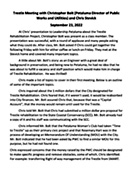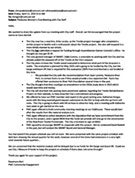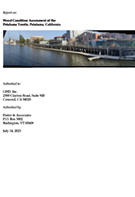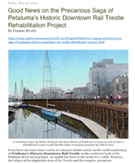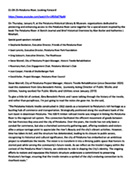“Moisture content readings taken primarily on the stringers and ties indicate the conditions, at the time of the assessment, were not favorable for active wood decay."
“For existing structures, the engineer often relies on assumed species and current standards to determine the adequacy of the wood members to remain in service. Since many structures were built before building codes or design values for wood products were established (and, thus, before grade stamps were used), engineers are often in a quandary when determining what design values are appropriate. Frequently an assumed species and grade are assigned, only to show that the wood members are structurally deficient. The result is often an overly conservative estimate of design values and unnecessary replacement and repair decisions with the associated unnecessary project costs.”(Pg 12)
“Of the 35 pile caps we were able to inspect, we found nine that … likely require replacement in kind,”(pg 16)
“Approximately 23% of the ties have large internal decay voids”(pg 17)
“Many of the sway braces are of high-quality wood and are in serviceable condition as is. Should there be a need to repair or replace the piles, the sway braces should be replaced in-kind.” (pg 21)
"Because of the combination of species, the structural grade that can be assigned to the pile caps is Select Structural, Redwood Timbers.”
“The structural grade of the timber stringers is Select Structural, Douglas Fir - Larch Beams and Stringers”
Condition of components:
“The pile caps and stringers were pressure treated with creosote. The creosote treatment has largely been effective in protecting the pile caps and stringers against biodeterioration…”
Caps
“The condition of the pile caps is, generally, poor-to-excellent” (9 out of 35 will require replacement)
Stringers
“The condition of the stringers is, generally, fair-to-excellent”
Ties
“Approximately 23% of the ties have large internal decay voids”
Piles
“Of the 44 piles assessed (out of 180) approximately 75% were solid with no internal voids.”
(Pgs 22-23)
Timber Grades
“The wood species of the structural members in the Trestle (piles, pile caps, stringers, sway braces, and the ties and planks forming the deck) is a combination of Douglas-fir and redwood.
Stringers
Ties
Recommendations
1. Subject to engineering requirements, most of the pile caps can likely remain in service. Some reinforcement or replacement of those with large voids may be necessary.
2. Subject to engineering requirements, most of the stringers can likely remain in service. Repairs or reinforcement of deteriorated stringer ends where they bear on the pile caps should be considered by the structural engineer to provide adequate bearing for the deck, recognizing that there is considerable redundancy provided by the six stringers spanning between bents.
3. The sway braces will need to be replaced if the piles are repaired, in which case the replacement braces should be of Select Structural Douglas Fir – Larch Visually Graded Dimension Lumber.
4. Because of the close spacing of the ties, individual ties with minor deterioration can either be replaced or remain in service so long as remedial preservative treatment (such as borate rods) is applied


